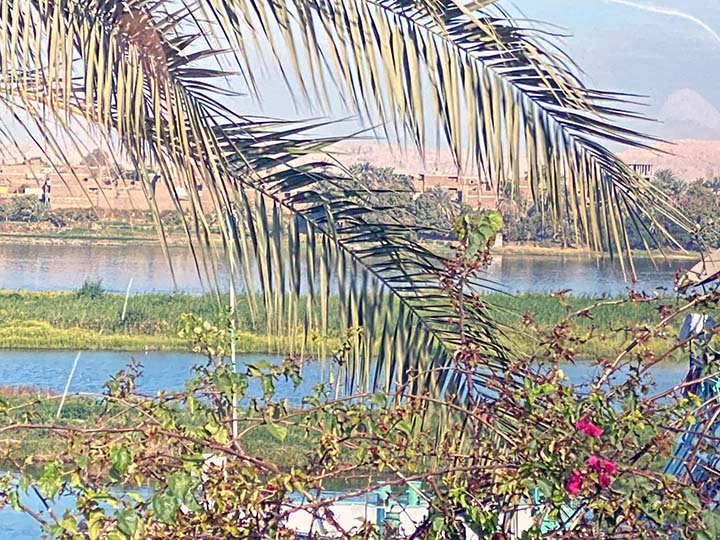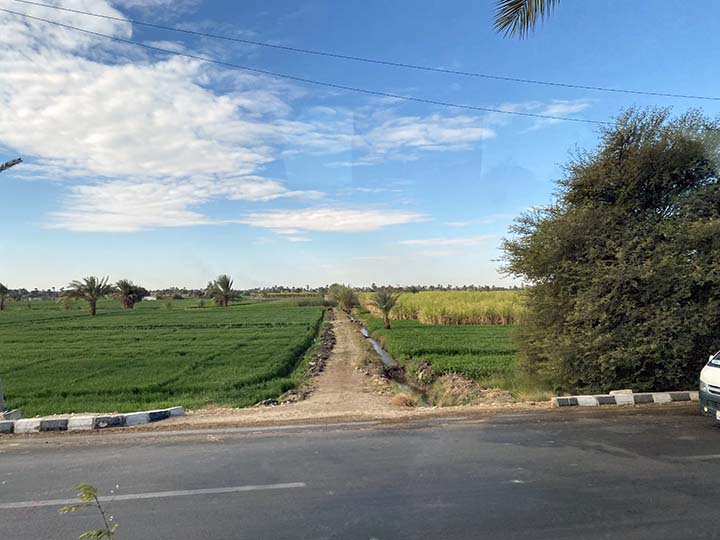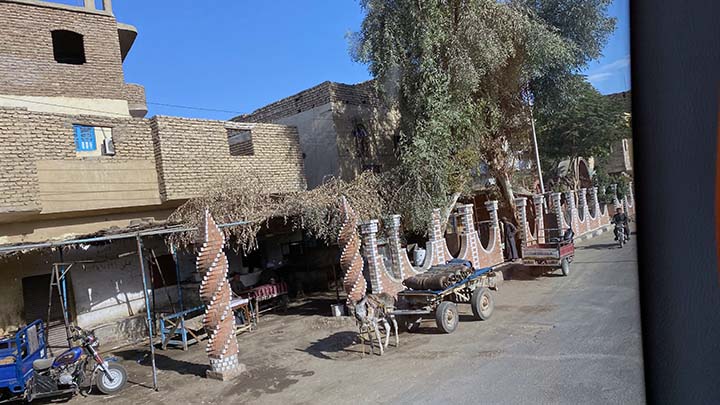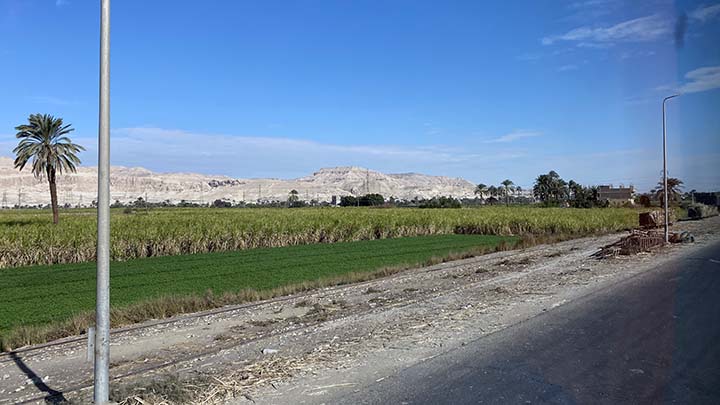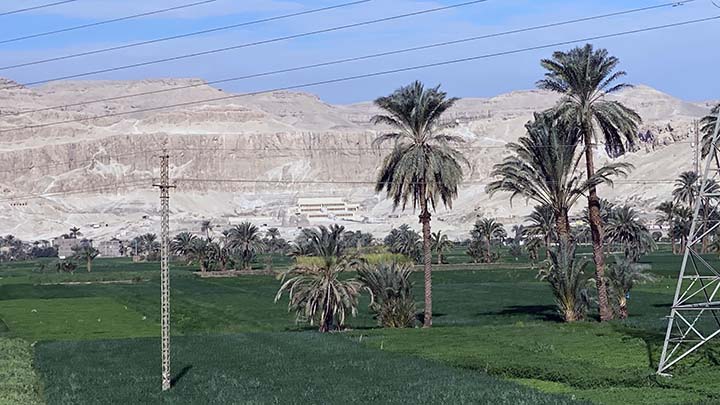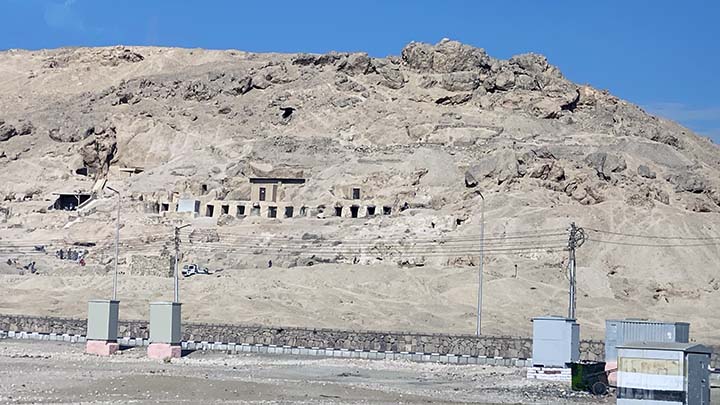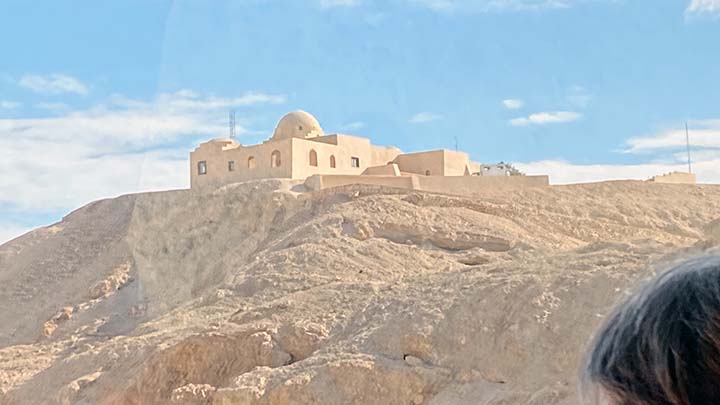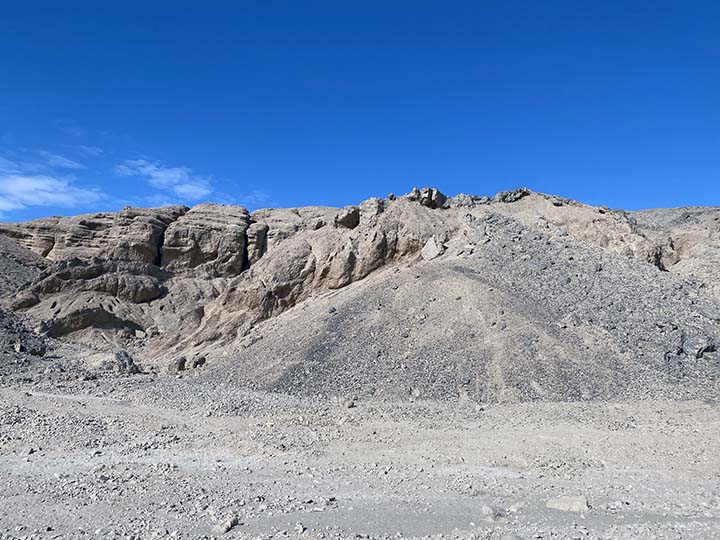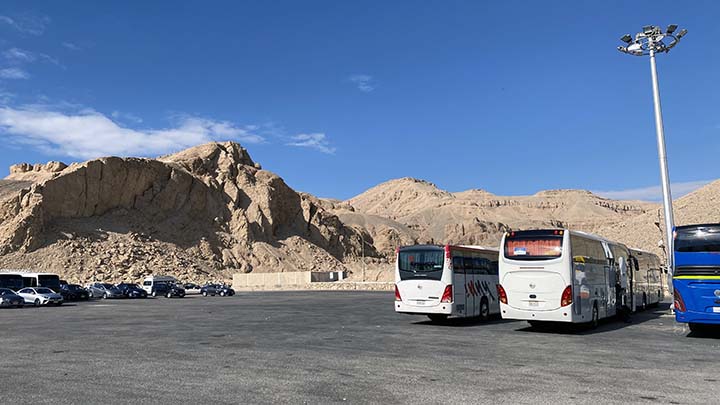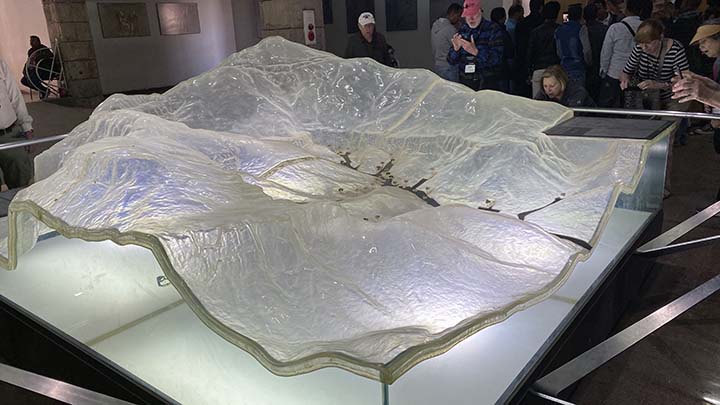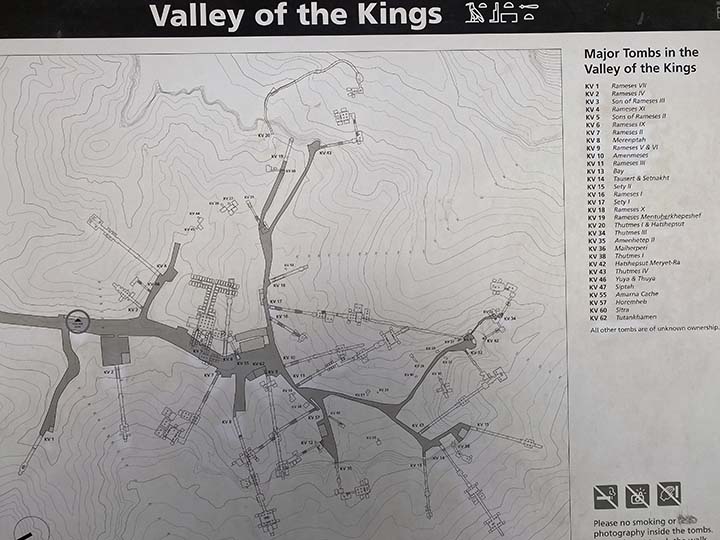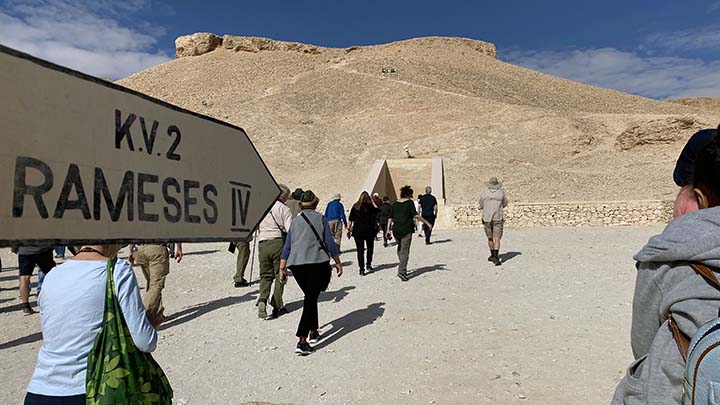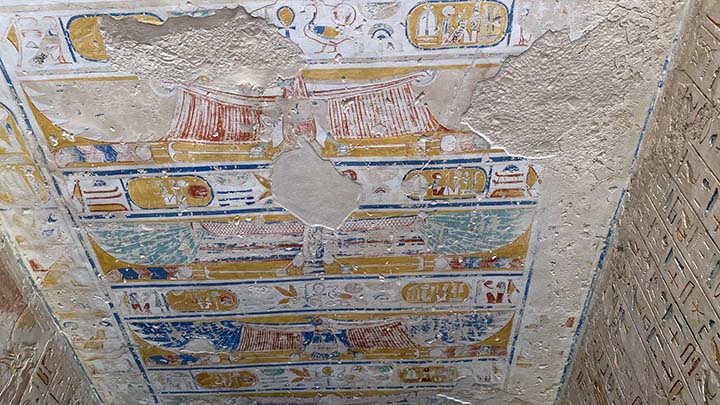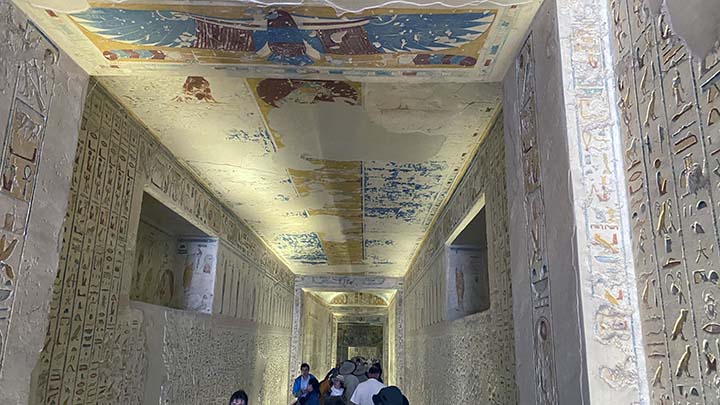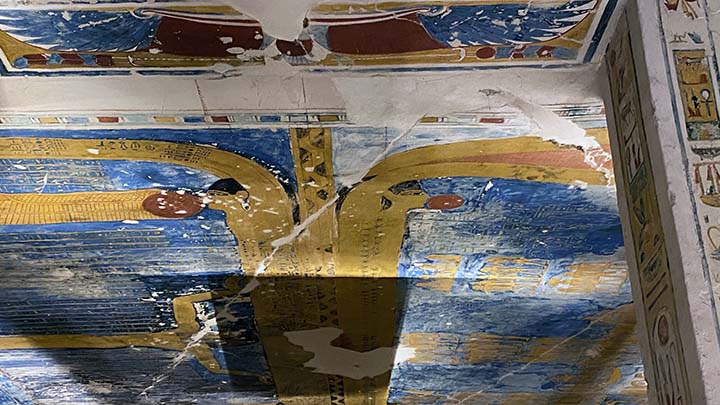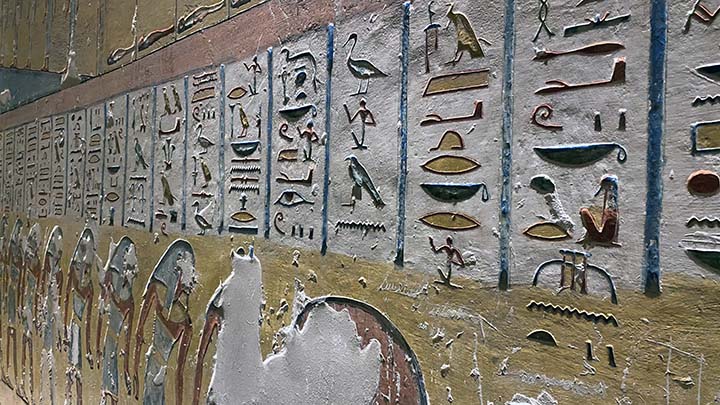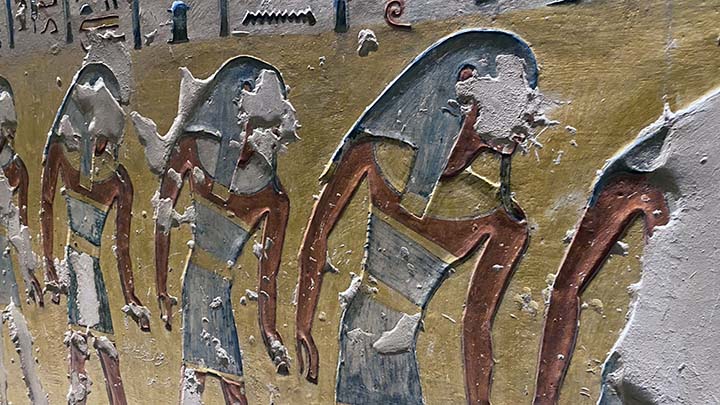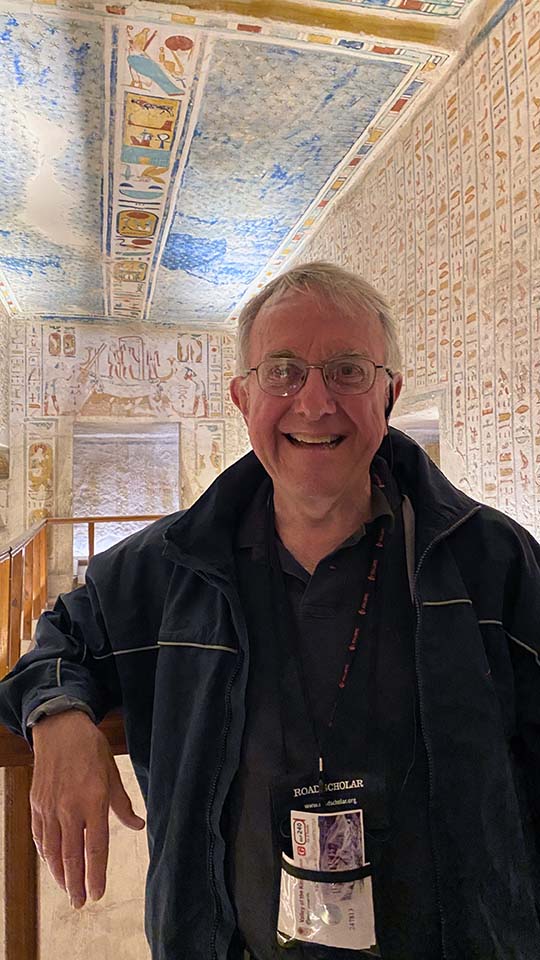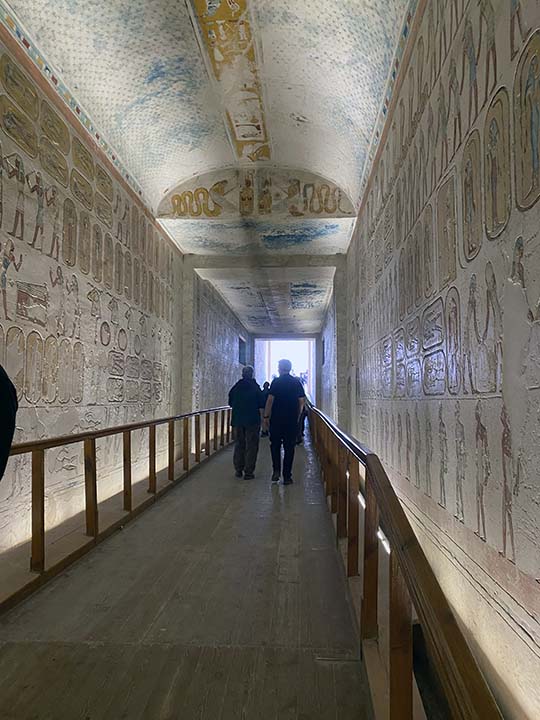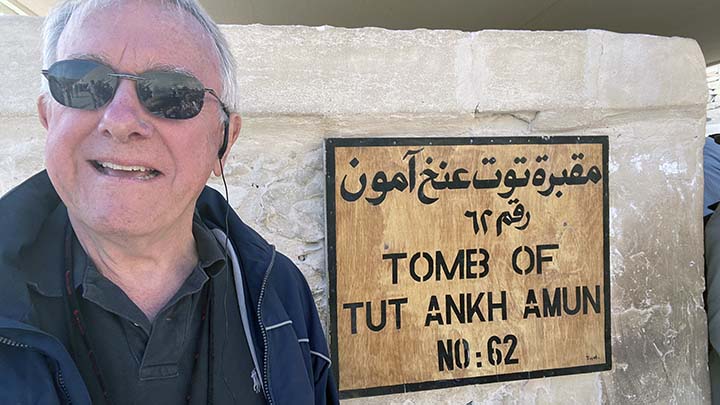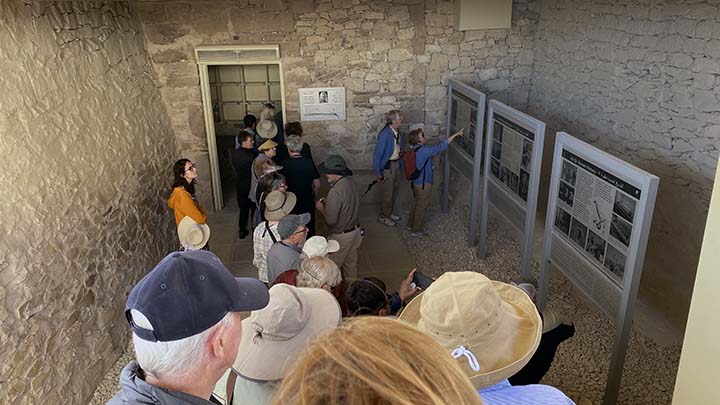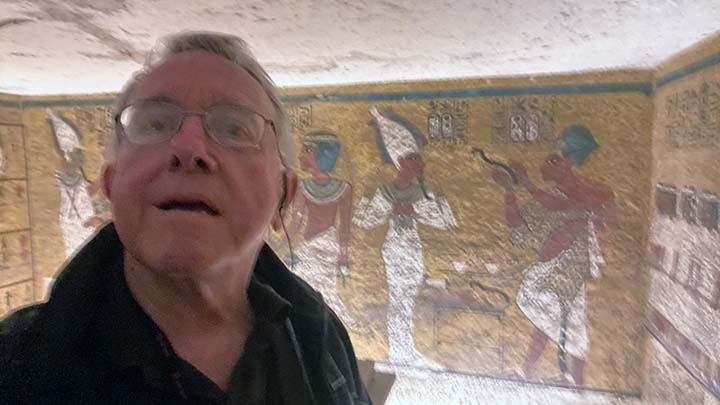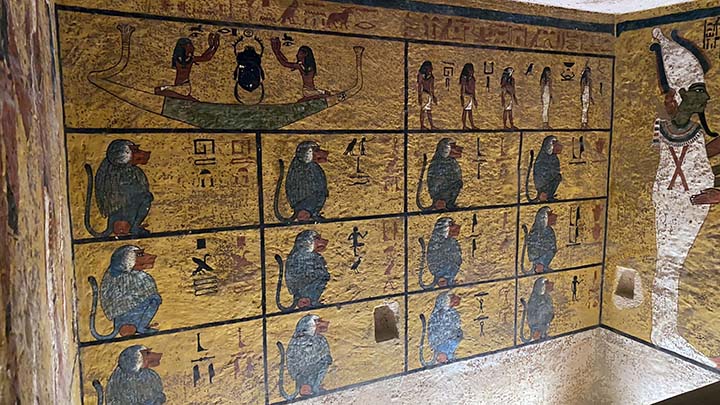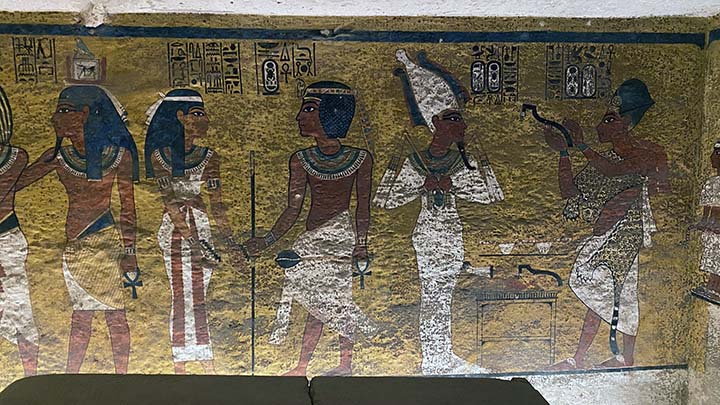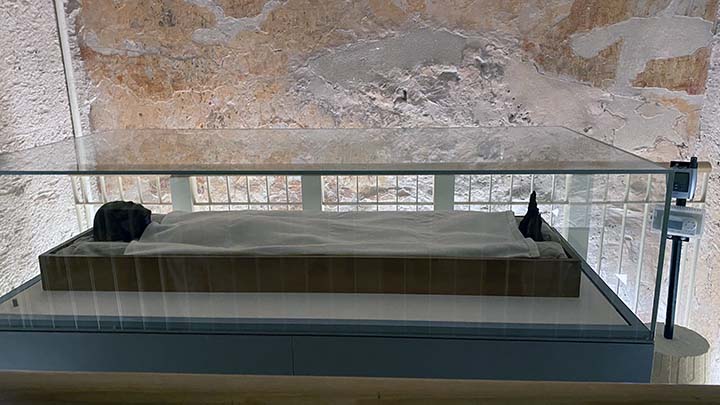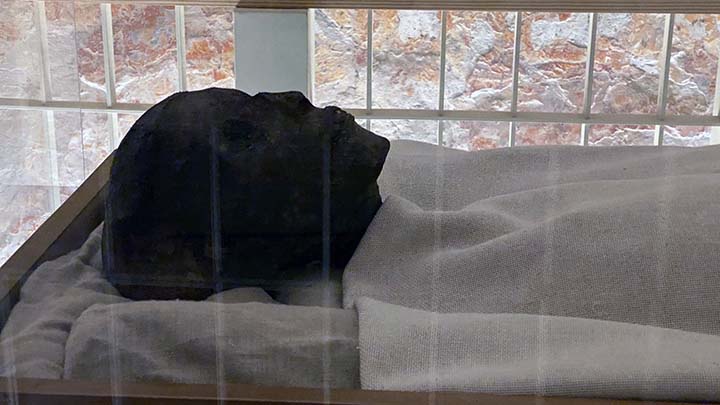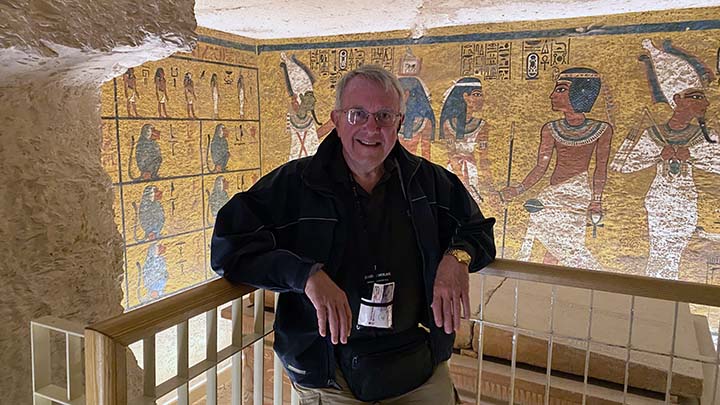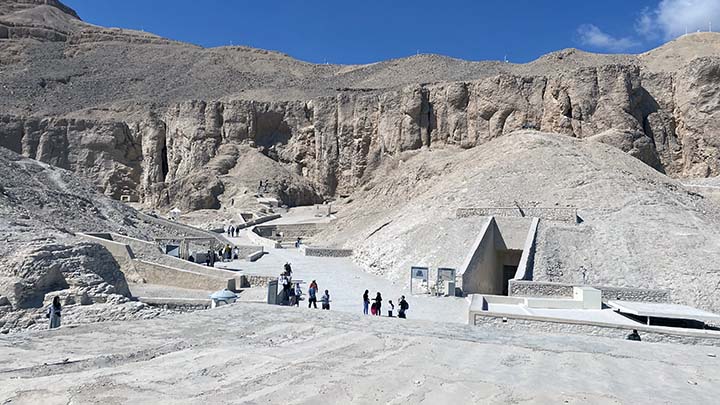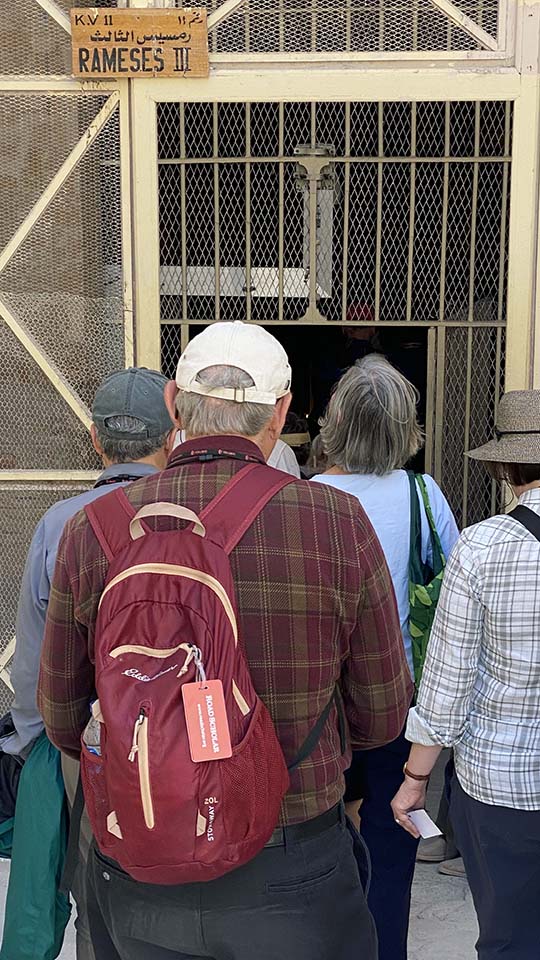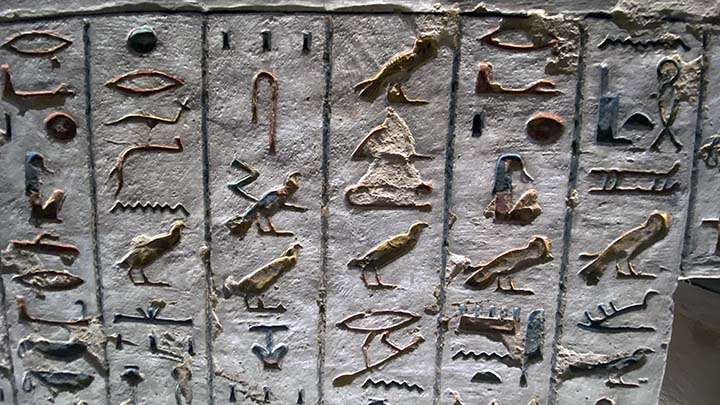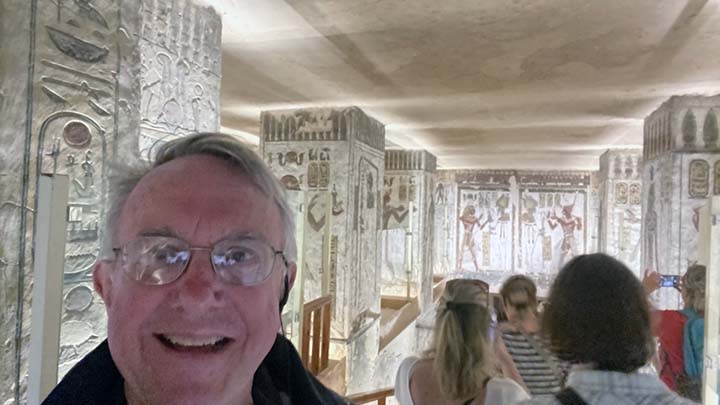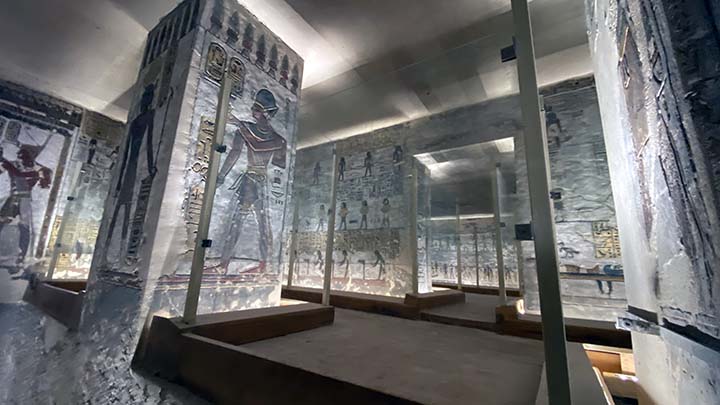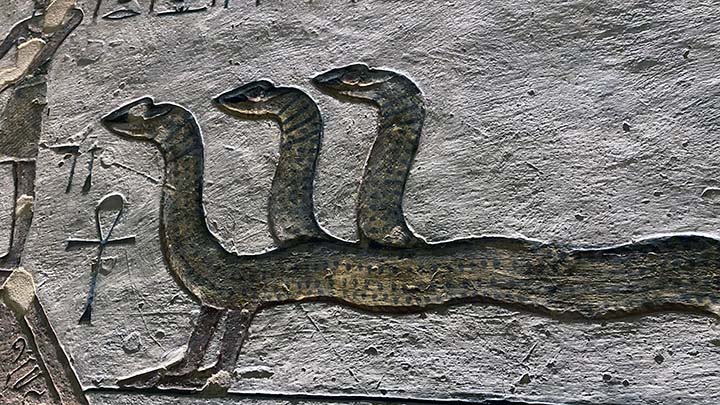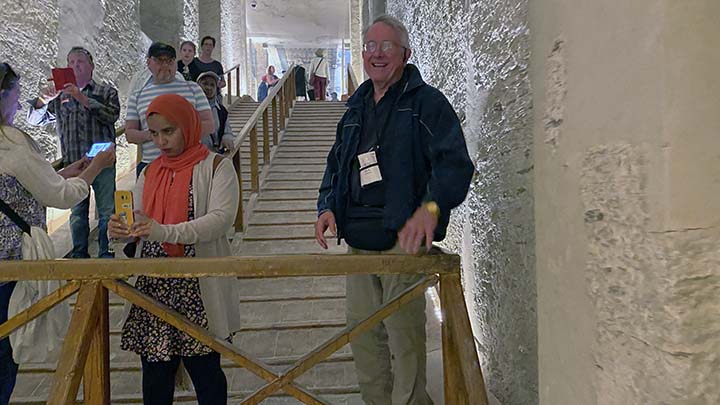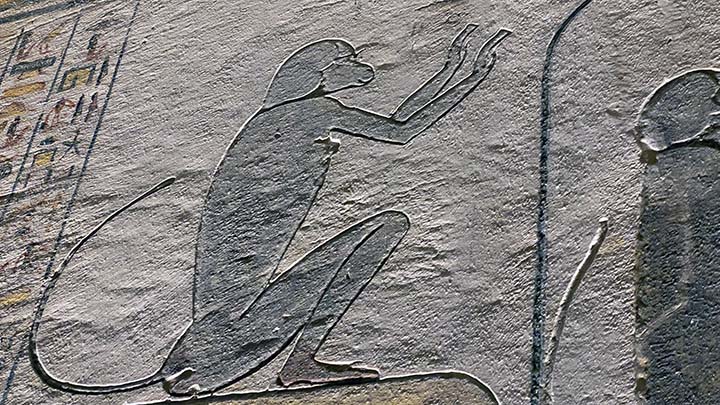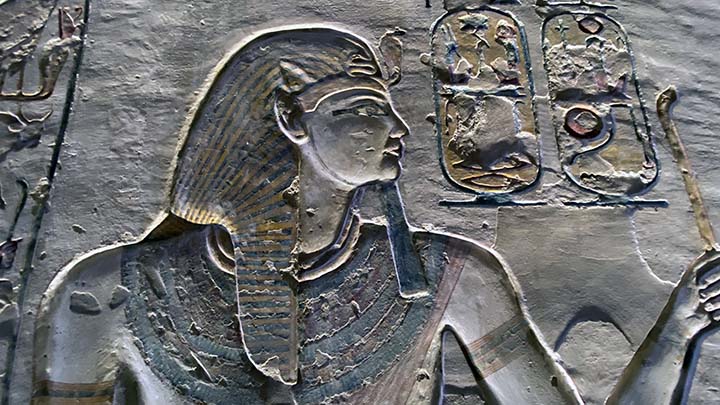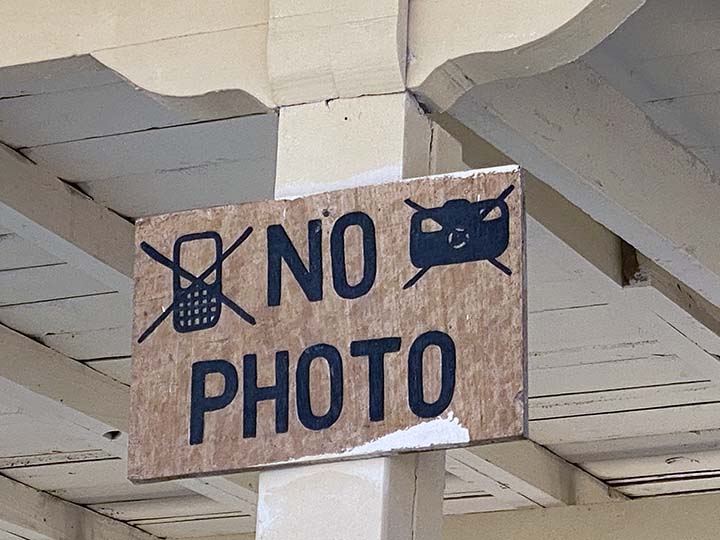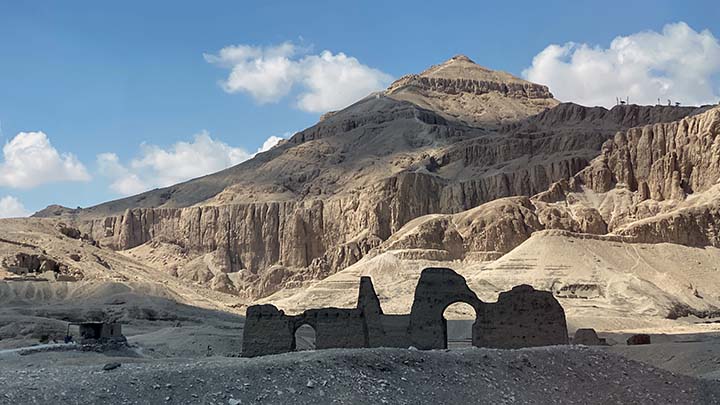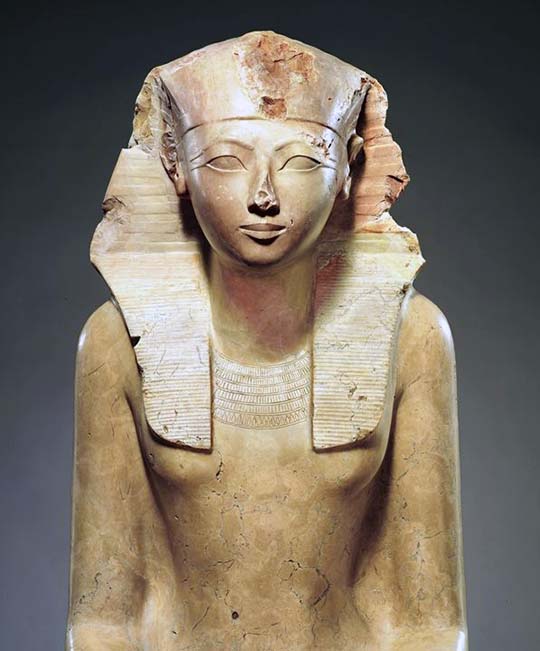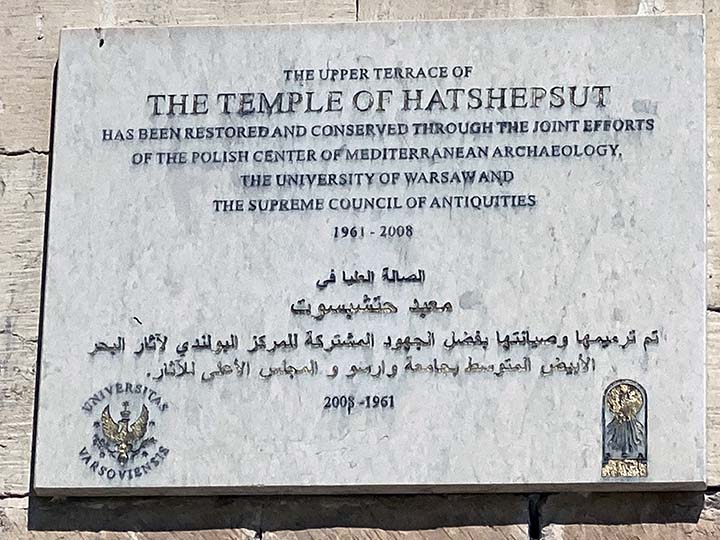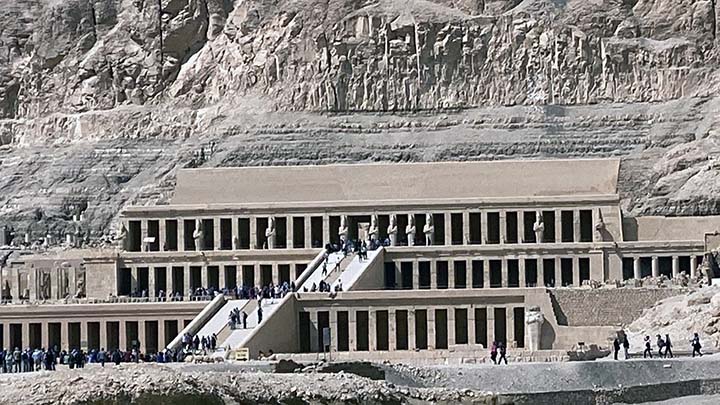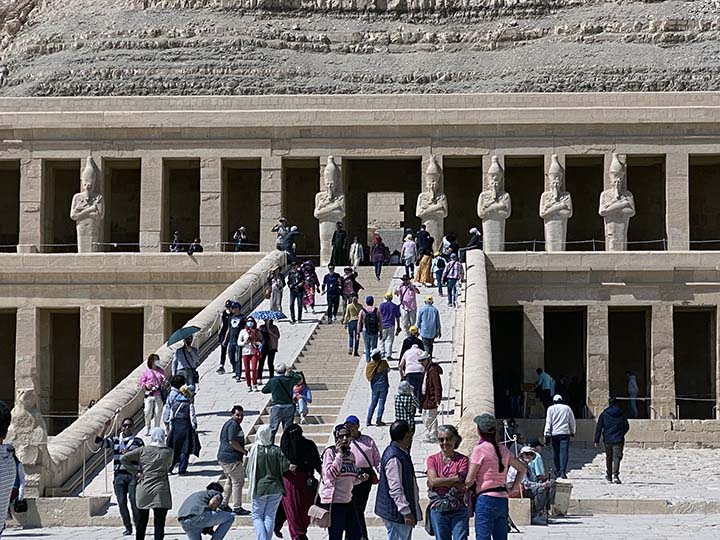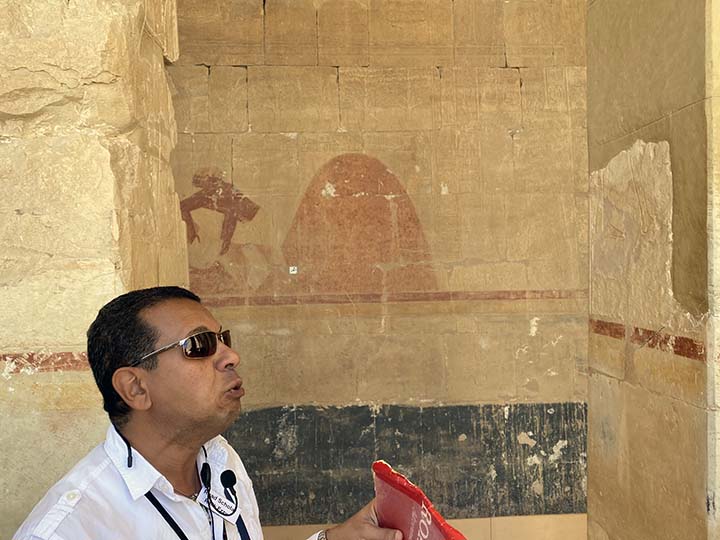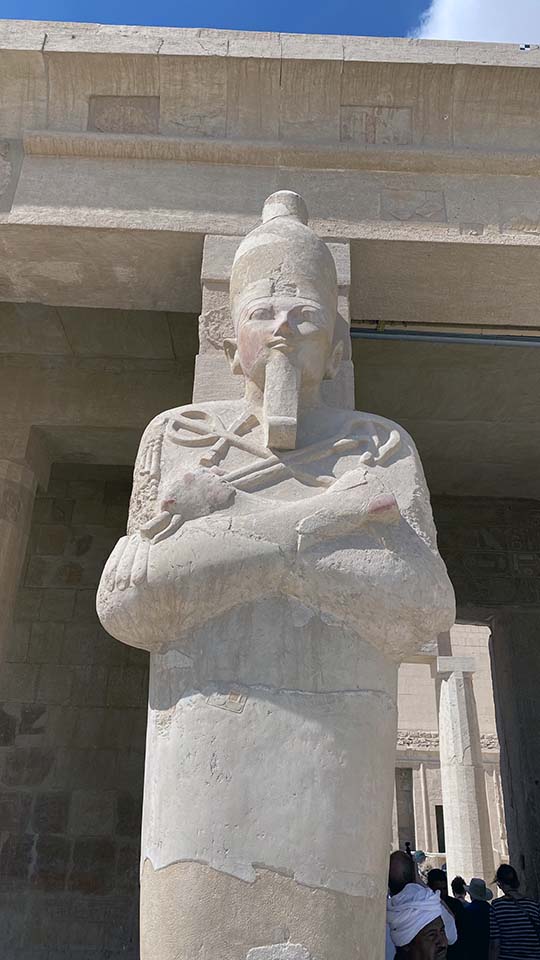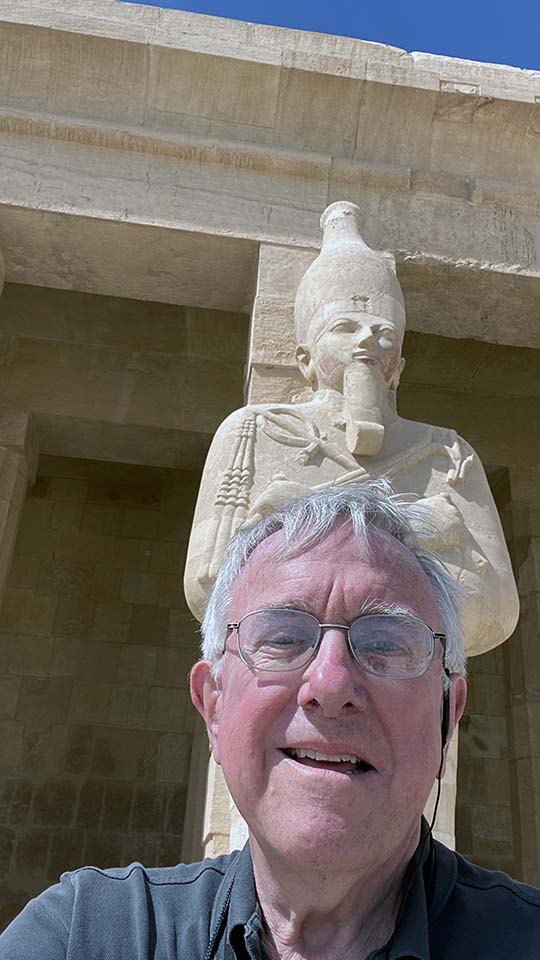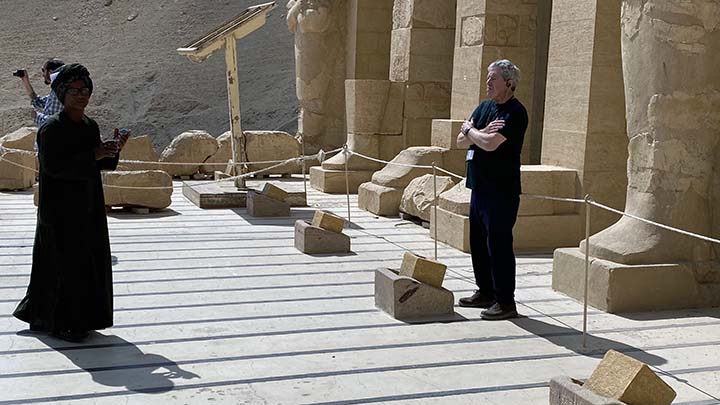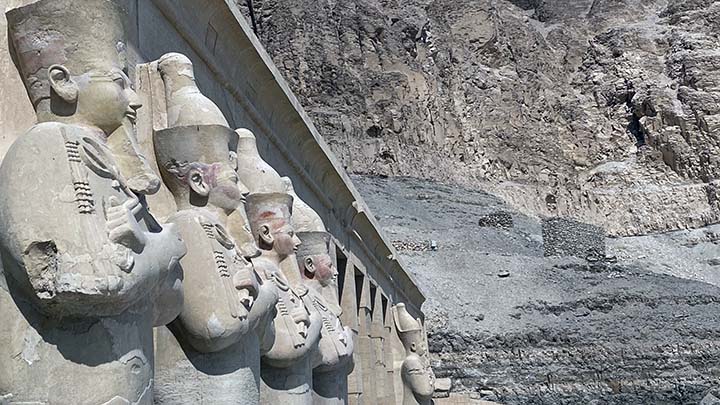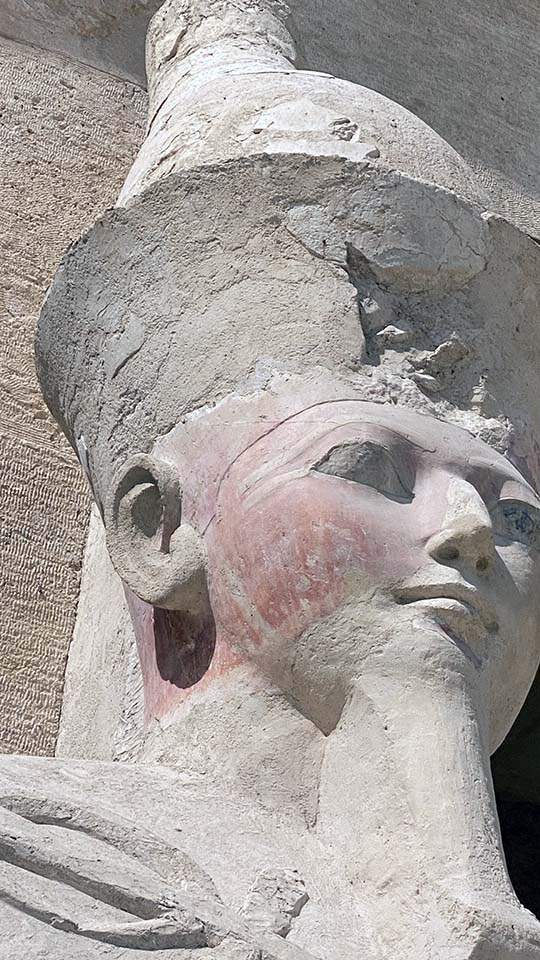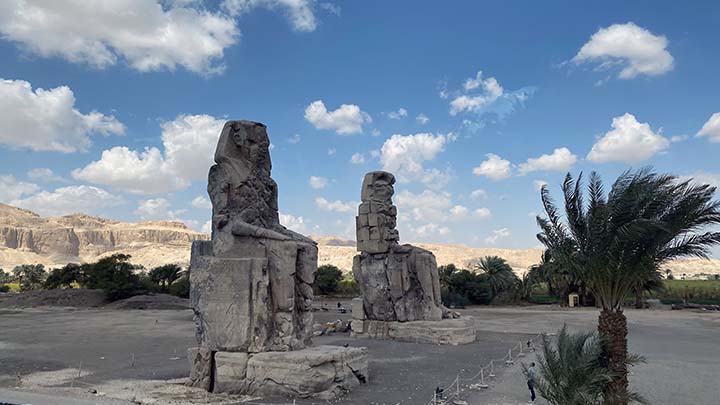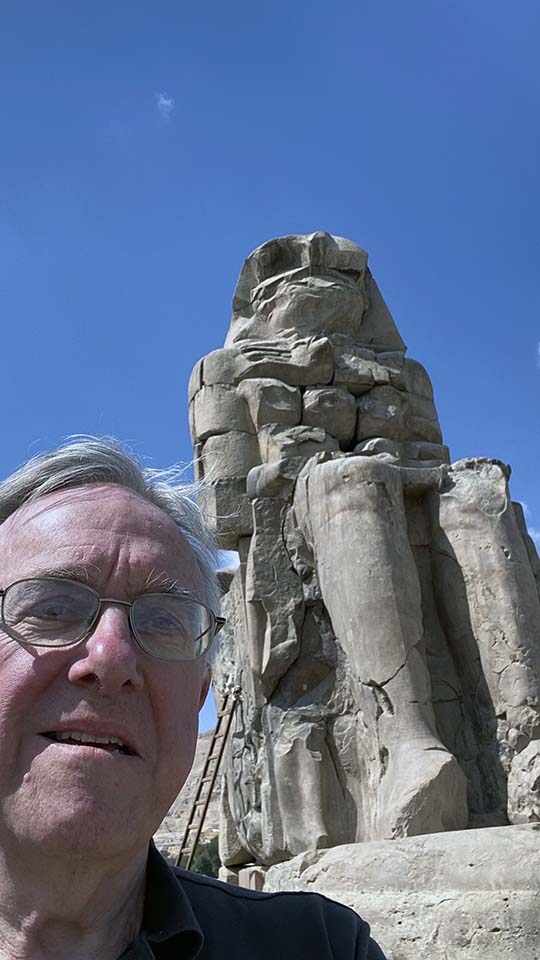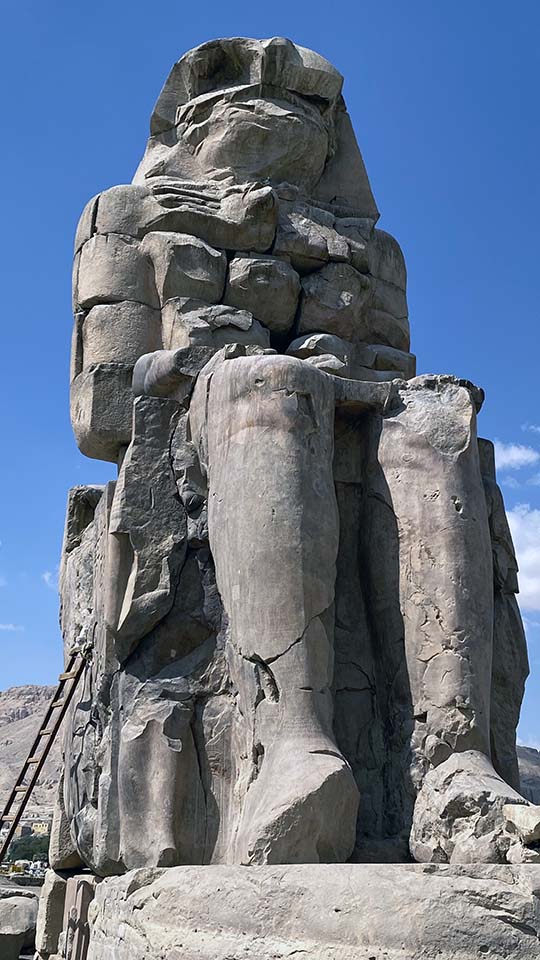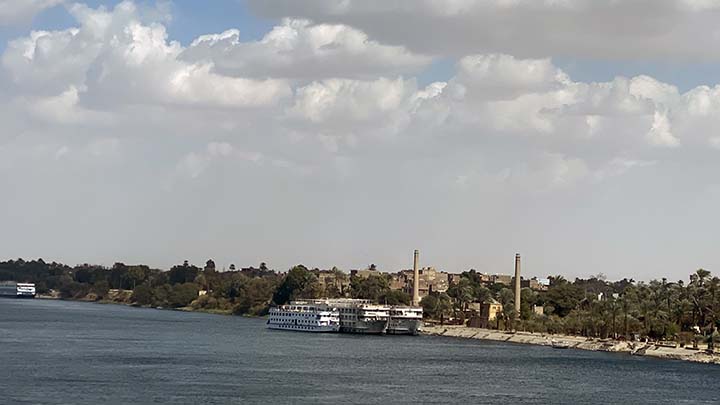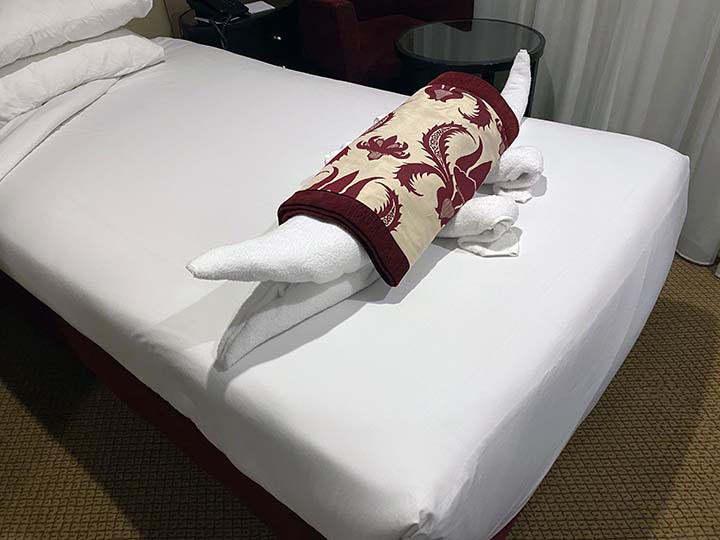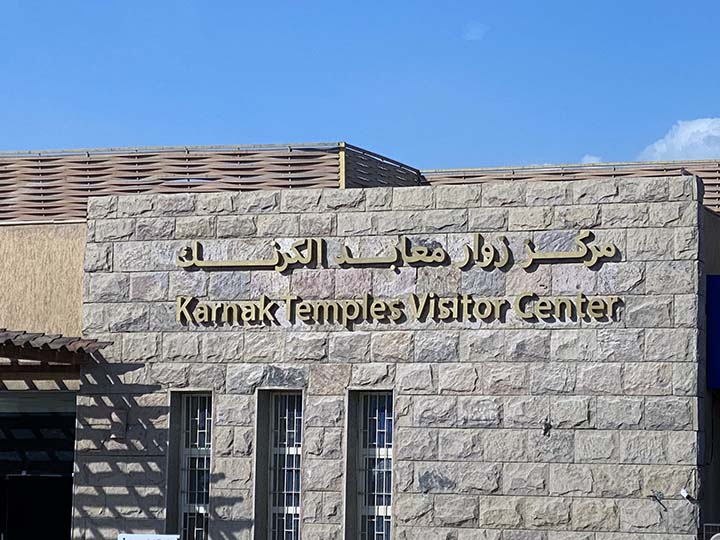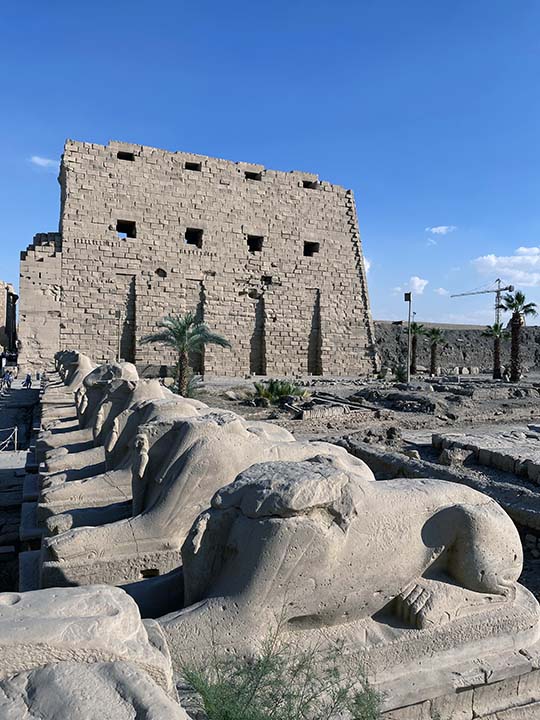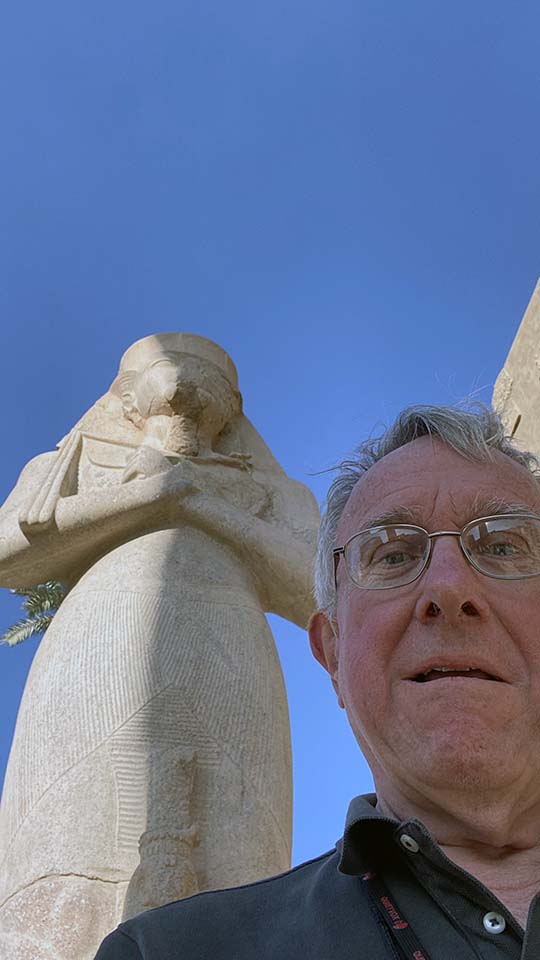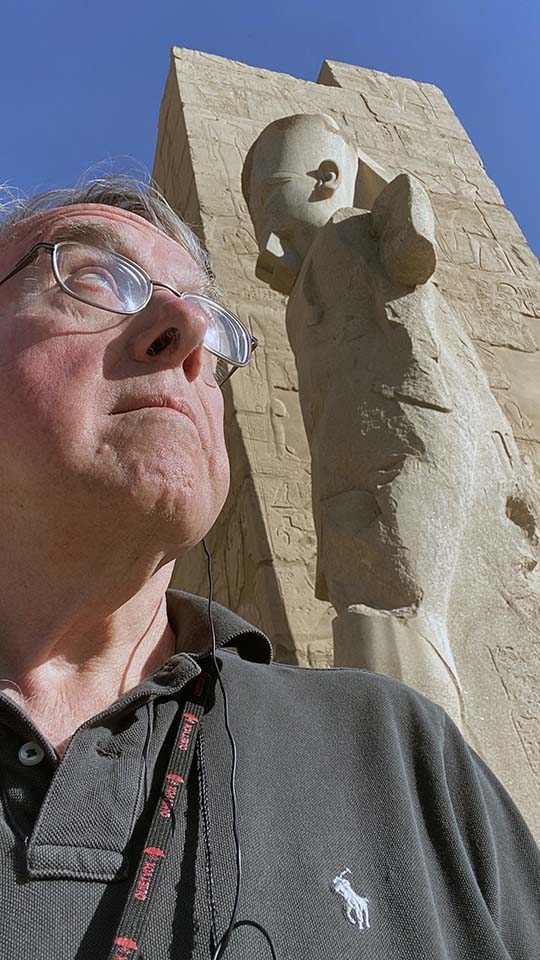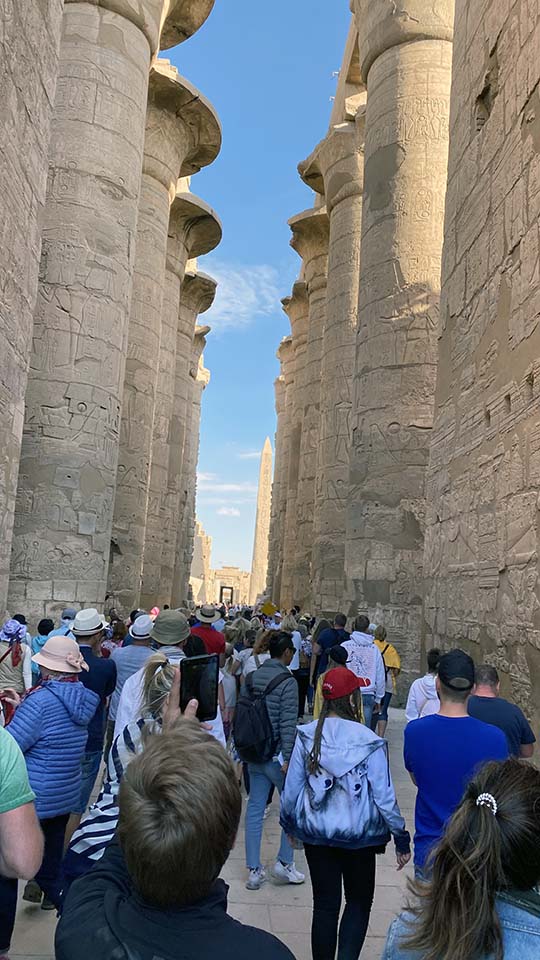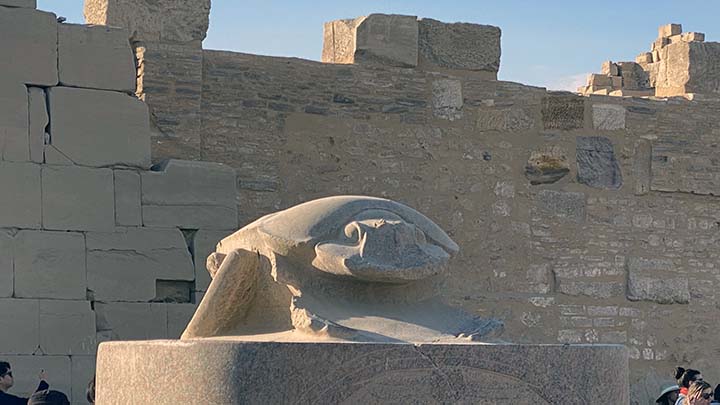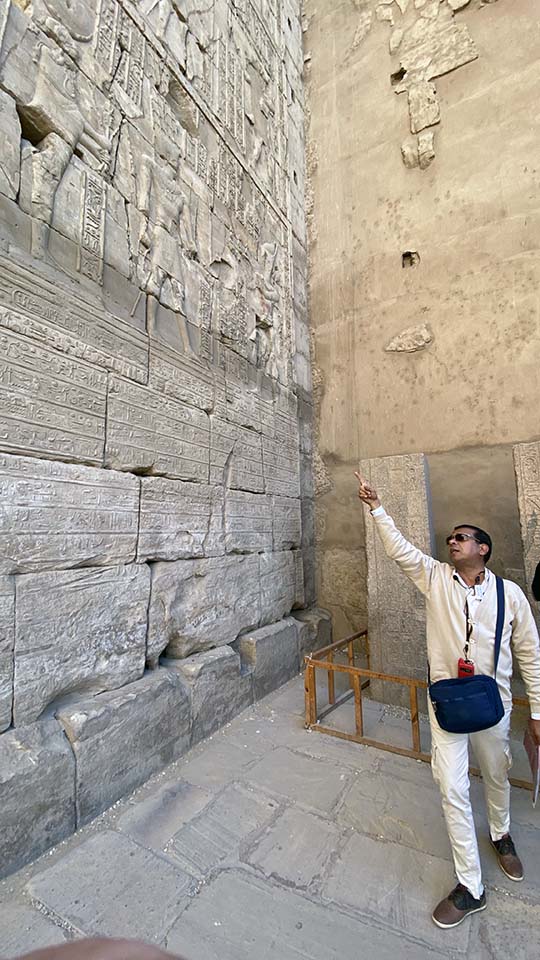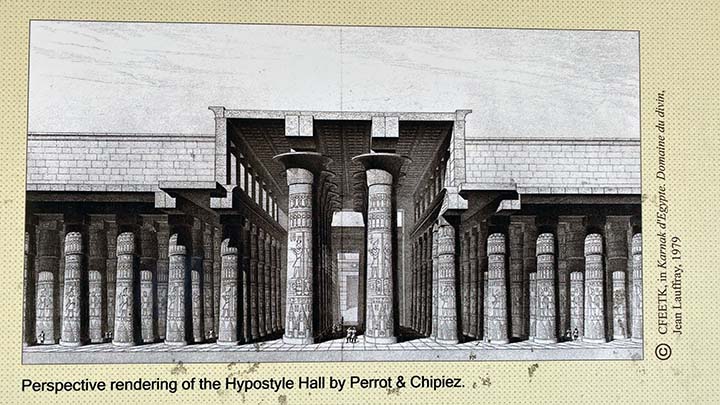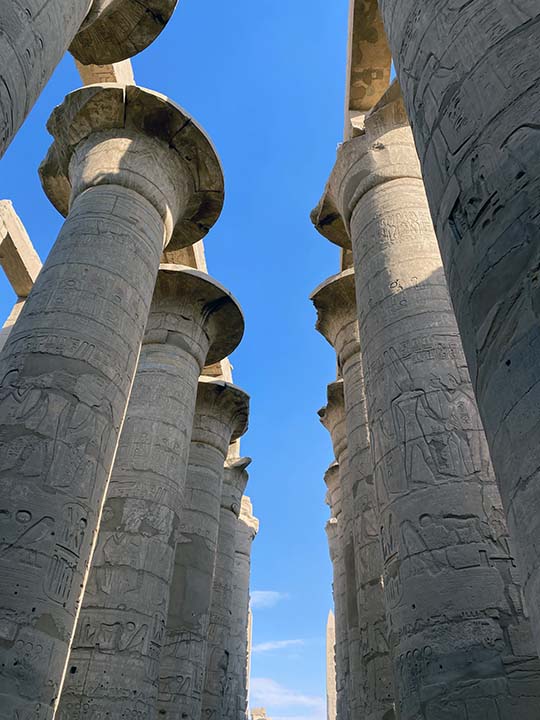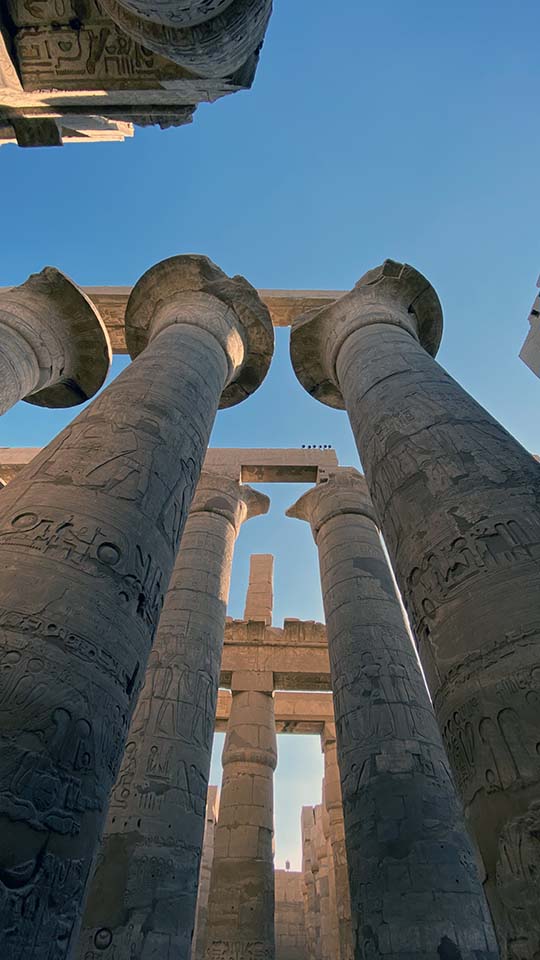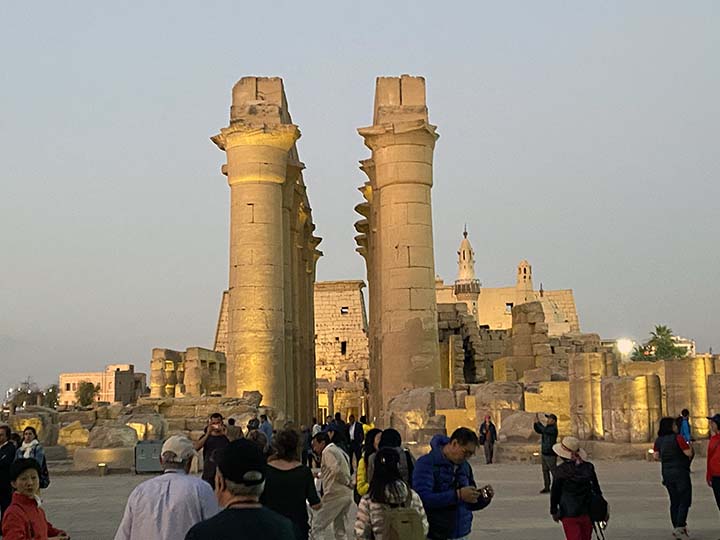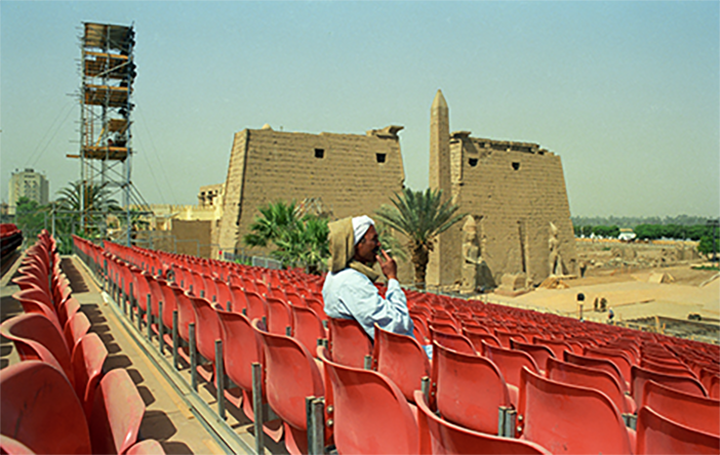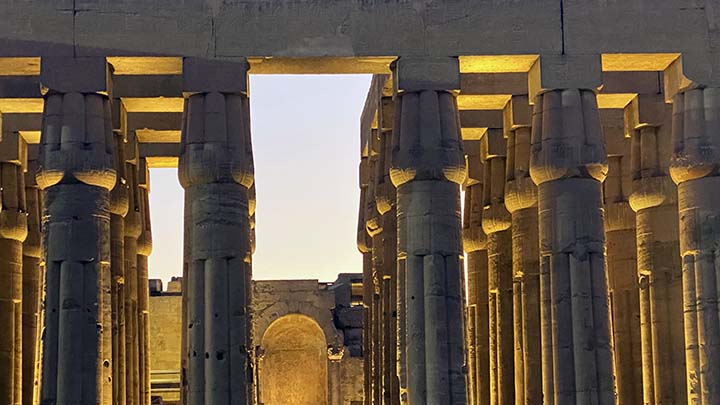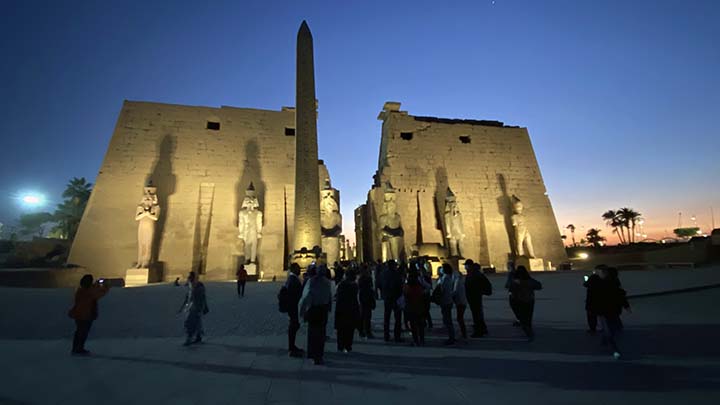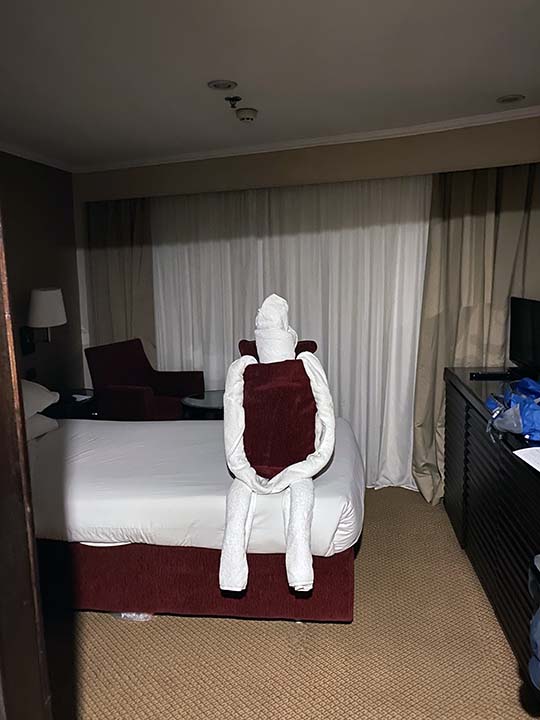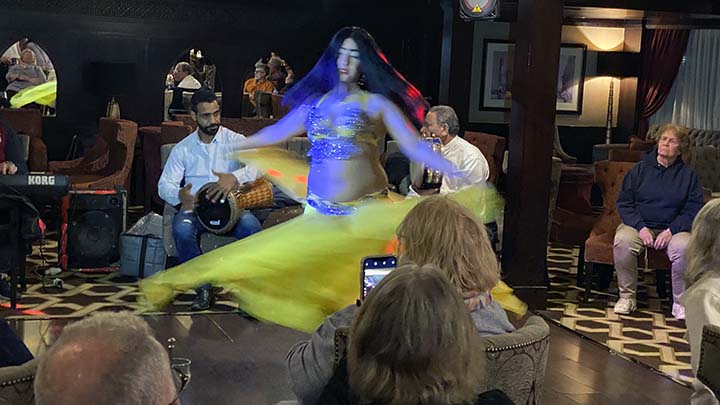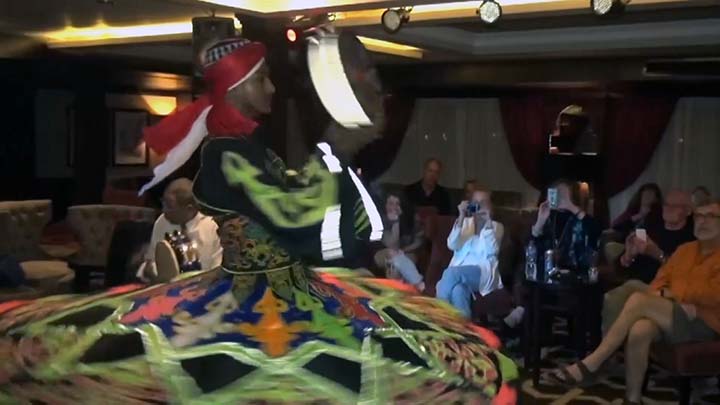|
I debated whether to title this album Luxor or just continue to say I’m on the Nile. We spent the night on the boat, but we docked at Luxor, and the name of the ancient capital of Egypt has a certain cachet. Luxor was the center of power for the world’s first nation state, and there are ancient temples around here like you wouldn’t believe. It was a long day, so there will be lots of pictures on this page but only a fraction of the number of pictures I took.
See all that sandy, rocky, dry, dead land across the Nile? That’s where the Valley of the Kings lies. I'm not sure what I did to my iPhone camera settings to produce the odd colors in this photo, but I sorta like it the way it is.
We're leaving the fertile land near the Nile and heading out into the desert.
Roadwork on a beautiful morning.
Well those are some interesting...columns?
We're running out of arable land.
I think I see something old over there.
Yep. Somebody's been digging in those hills.
Lord Carnarvon funded the expedition that discovered King Tut’s tomb right here in the Valley of the Kings. That’s his guest house up there. Know where he lived when he was at home in England? Downton Abbey, or, as his lordship called it, Highclere Castle.
They say there are fabulous tombs to be found around here.
So let's have a look.
We were warned that before we could get into the Valley of the Kings we'd have to run a gantlet of high-pressure trinket salesmen. The warning was accurate.
The visitors center featured a model of the area.
The Valley of the Kings is a valley in Egypt where, for a period of nearly 500 years from the 16th to 11th century BC, rock cut tombs were excavated for the pharaohs and powerful nobles of the New Kingdom (the Eighteenth to the Twentieth Dynasties of Ancient Egypt). The Road Scholars are riding a tram up to the excavation site.
Today I learned that as soon as somebody became pharaoh, or king,
the palace staff began digging a tomb and they worked on it until
the pharaoh died. (I wonder if that made the new pharaoh nervous?)
The valley stands on the west bank of the Nile, opposite Thebes (modern Luxor), within the heart of the Theban Necropolis. The wadi consists of two valleys, East Valley (where the majority of the royal tombs are situated) and West Valley. With the 2005 discovery of a new chamber and the 2008 discovery of two further tomb entrances, the valley is known to contain 64 tombs and chambers (ranging in size from KV54, a simple pit, to KV5, a complex tomb with over 120 chambers). It was the principal burial place of the major royal figures of the Egyptian New Kingdom, as well as a number of privileged nobles. The royal tombs are decorated with scenes from Egyptian mythology and give clues as to the beliefs and funerary practices of the period. Almost all of the tombs seem to have been opened and robbed in antiquity, but they still give an idea of the opulence and power of the pharaohs. This area has been a focus of archaeological and Egyptological exploration since the end of the eighteenth century, and its tombs and burials continue to stimulate research and interest. In modern times the valley has become famous for the discovery of the tomb of Tutankhamun (with its rumors of the curse of the pharaohs), and is one of the most famous archaeological sites in the world. In 1979, it became a World Heritage Site, along with the rest of the Theban Necropolis. Exploration, excavation and conservation continues in the valley, and a new tourist center has recently been opened.
Originally intended to be much larger, KV 2 was cut short at 290 ft on the early death of the pharaoh (1147 BC) and a pillared hall was converted to be the burial chamber. The sarcophagus is in place with a magnificent goddess Nut filling the ceiling above it. Close to the entrance of the valley, this tomb was opened in antiquity and inhabited (there is Greek, Roman and Coptic graffiti), and used as a hotel by many 18th- and 19th-century visitors.
People come from all over the world to see this.
Close to the entrance of the valley, this tomb was opened in antiquity and inhabited (there is Greek, Roman and Coptic graffiti), and used as a hotel by many 18th- and 19th-century visitors.
So people have been traipsing around in here for quite a while.
Doesn’t seem to have harmed the decorations very much.
At least not the ones that vandals didn’t get their hands on.
The tourist's mind is blown.
Here, see for yourself what it's like to stand in one of these ancient tombs.
The colors are still vibrant after all these years.
Vandals objected to faces for some reason.
The tourist's face is still smiling, though.
Let's go see more tombs.
The tourist is about to visit maybe the most famous tomb of all around here.
Tutankhamun (c. 1342 – c. 1325 BC), was an ancient Egyptian pharaoh who was the last of his royal family to rule during the end of the 18th Dynasty (ruled c. 1334 – 1325 BC in the conventional chronology) during the New Kingdom of Egyptian history. His father was the pharaoh Akhenaten, believed to be the mummy found in the tomb KV55. His mother is his father's sister, identified through DNA testing as an unknown mummy referred to as "The Younger Lady" who was found in KV35. Tutankhamun took the throne at eight or nine years of age under the unprecedented viziership of his eventual successor, Ay, to whom he may have been related. He married his half sister Ankhesenamun. Tutankhamun was physically disabled with a deformity of his left foot along with bone necrosis that required the use of a cane, several of which were found in his tomb. He had other health issues including scoliosis and had contracted several strains of malaria.
The Road Scholars have lined up with ordinary sightseers..
The tourist cranes his neck to see it all.
King Tut's tomb is beautiful.
Magnificent.
His tomb is not very big. All the treasures have been taken away to be displayed in museums, and pretty much all that’s left are the wall decorations. And poor old Tut.
Just look at him lying there, all mummified for the past 3,300 years. Of course he knew he was an important guy and would be remembered for a long time, but really he couldn't have foreseen what the future held. He had no idea that someday his head would be stuck at one end of a blanket with his feet at the other while a gazillion nobodies from all over the world would be defiling his final resting place day after day. The 1922 discovery by Howard Carter of Tutankhamun's nearly intact tomb, in excavations funded by Lord Carnarvon, received worldwide press coverage. With over 5,000 artifacts, it sparked a renewed public interest in ancient Egypt, for which Tutankhamun's mask, now in the Egyptian Museum, remains a popular symbol. The deaths of a few involved in the discovery of Tutankhamun's mummy have been popularly attributed to the curse of the pharaohs. He has, since the discovery of his intact tomb, been referred to colloquially as "King Tut".
King Tut Song by Steve Martin and the Toot Uncommons King Tut, King Tut Now if I'd known, they'd line up just to see
him (King Tut) Dancing by the Nile (Disco Tut) Golden idols He's an Egyptian! They're selling you... (King Tut) Now when I die, now, don't think that I'm a
nut (King Tut) He was born in Arizona... King Tut
And now look at the tourist standing there, smiling, and yes, aware there's a bad virus going around over in China somewhere, but totally unconcerned, as clueless as King Tut about what's coming next. He thinks this is just the first of his trips in 2020. Ha. Ha. Ha..
There's more to see in the Valley of the Kings.
Tomb KV11 is the tomb of ancient Egyptian Pharaoh Ramesses III. Located in the main valley of the Valley of the Kings, the tomb was originally started by Setnakhte, but abandoned when it broke into the earlier tomb of Amenmesse (KV10). Setnakhte was buried in KV14. The tomb KV11 was restarted and extended and on a different axis for Ramesses III.
The tomb has been open since antiquity, and has been known variously as "Bruce's Tomb" (named after James Bruce who entered the tomb in 1768) and the "Harper's Tomb" (due to paintings of two blind harpers in the tomb).
The 617 ft long tomb is beautifully decorated.
Riding along to the afterlife.
Being welcomed to the underworld.
The tourists continues to be impressed.
The burial chamber is an eight-pillared hall in which stood the red quartzite sarcophagus (which is now in the Louvre, while its lid is in the Fitzwilliam Museum in Cambridge).[1] This chamber is decorated with Book of Gates, divine scenes and the Book of the Earth. Beyond this is a further set of annexes, decorated with the Book of Gates.
A monster of the underworld.
The tomb was first mentioned by an English traveler Richard Pococke in the 1730s, but its first detailed description was given by James Bruce in 1768. Preliminary scientific studies were made by French scholars, who had come to Egypt with Napoleon.
You're not going to talk me into going in there. I've seen the movie.
The tourist can't get enough.
He'll take photos of monkeys.
He'll take photos of gods.
He'll even take photos of the don't take photos sign.
Say goodbye to the Valley of the Kings. Next up: the Mortuary Temple of Hatshepsut.
So who was Hatshepsut, you ask? This statue of her is at the Metropolitan Museum of Art in New York. I grabbed the picture off the internet so we can see what she looked like. Hatshepsut, "Foremost of Noble Ladies," (1507–1458 BC) was the fifth pharaoh of the Eighteenth Dynasty of Egypt. She was the second historically confirmed female pharaoh. Hatshepsut came to the throne of Egypt in 1478 BC. Her rise to power was noteworthy as it required her to utilize her bloodline, education, and an understanding of religion. Her bloodline was impeccable as she was the daughter, sister, and wife of a king. Hatshepsut's understanding of religion allowed her to establish herself as the God's Wife of Amun. Officially, she ruled jointly with Thutmose III, who had ascended to the throne the previous year as a child of about two years old. Hatshepsut was the chief wife of Thutmose II, Thutmose III's father. She is generally regarded by Egyptologists as one of the most successful pharaohs, reigning longer than any other woman of an indigenous Egyptian dynasty. According to Egyptologist James Henry Breasted, she is also known as "the first great woman in history of whom we are informed."
The Road Scholars are ready for a new adventure.
And they're off!
The Mortuary Temple of Hatshepsut, also known as the Djeser-Djeseru ("Holy of Holies"), is a mortuary temple of Ancient Egypt located in Upper Egypt. Built for the Eighteenth Dynasty pharaoh Hatshepsut, who died in 1458 BC, the temple is located beneath the cliffs at Deir el-Bahari on the west bank of the Nile near the Valley of the Kings. This mortuary temple is dedicated to Amun and Hatshepsut and is situated next to the mortuary temple of Mentuhotep II, which served both as an inspiration and, later, a quarry. It is considered one of the "incomparable monuments of ancient Egypt."
Hatshepsut proceeded to feminize Egypt. Her reign included no great military conquests; the art produced under her authority was soft and delicate; and she constructed one of the most elegant temples in Egypt against the cliffs outside the Valley of the Kings. Built beside the famous mortuary temple of Montuhotep I, Hatshepsut's version elongated the original design to produce a different aesthetic. A long ramp ascended to a wide terrace from a courtyard filled with pools and trees. Bordered by a sweeping wall of columns, the terrace stretched the length of Montuhotep's entire temple, and held a ramp that ascended to a second terrace, also lined by a sweeping wall of columns. Atop its columned halls, whose walls were covered with lovely carvings, stood the temple proper whose smaller rooms contained statues of the queen. Some wall scenes showed her birth as a divine event in which the god Amun, disguised as her father Thuthmose I, impregnated her mother, indicating that the god had personally placed her on the throne. -- Historians Bob Brier and Hoyt Hobbs
Wow.
Really, just wow.
Rafik tells us all about it.
The tourist is still working on his falcon impression.
The statues are massive.
And you can even see some of the original paint job if you look closely. Or maybe that's sunburn.
The tourist might agree.
Apparently Don is communing with a priest.
The reign of Queen Hatshepsut lasted 22 years and in that time she was responsible for more building projects than any pharaoh in history save Rameses II (also known as Rameses the Great, 1279-1213 BCE). Although historians recognize her rule as one of peace and prosperity there is evidence that, early on, after she had claimed descent from Amun, she led military expeditions against the neighboring countries of Syria and Nubia. She sent expeditions to the land of Punt (present day Somalia) in ships seventy feet long, each manned with 210 sailors and 30 rowers. These expeditions brought back, among other things, live frankincense trees in baskets of their native soil (the first time in history plants or trees were transported from a foreign land successfully for transplant) and had them situated to adorn her complex at Deir el-Bahri. This complex boasts perfect symmetry and was so awe-inspiring to the ancients that later pharaohs would choose the locale around her temple for their own tombs, an area known today as the Valley of the Kings. Hatshepsut, an admirer of Mentuhotep II’s temple had her own designed to mirror it but on a much grander scale and, just in case anyone should miss the comparison, ordered it built right next to the older temple. Hatshepsut was always keenly aware of ways in which to elevate her public image and immortalize her name; the mortuary temple achieved both ends.
Yep, sunburn. No doubt about it.
Archaeologists are still finding things around here. There's a newly discovered sphinx.
There are big statues all around this area.
Now we have stopped to admire the Colossi of Memnon, two massive stone statues of the Pharaoh Amenhotep III, who reigned in Egypt during the Dynasty XVIII. Since 1350 BCE, they have stood in the Theban Necropolis, located west of the River Nile from the modern city of Luxor.
This market is just across the street from those colossi. Oh boy, frish juice. I guess I shouldn't make fun of misspellings in English when I speak only one language.
The tourist keeps quoting Ozymandias in his head.
The Colossi of Memnon are two massive stone statues of the Pharaoh Amenhotep III, who reigned in Egypt during the Eighteenth Dynasty of Egypt. Since 1350 BCE, they have stood in the Theban Necropolis, located west of the River Nile from the modern city of Luxor. The twin statues depict Amenhotep III (fl. 14th century BCE) in a seated position, his hands resting on his knees and his gaze facing eastwards (actually ESE in modern bearings) towards the river. Two shorter figures are carved into the front throne alongside his legs: these are his wife Tiye and mother Mutemwiya. The side panels depict the Nile god Hapi. The original function of the Colossi was to stand guard at the entrance to Amenhotep's memorial temple (or mortuary temple): a massive construct built during the pharaoh's lifetime, where he was worshipped as a god-on-earth both before and after his departure from this world. In its day, this temple complex was the largest and most opulent in Ancient Egypt. Covering a total of 86 acres, even later rivals such as Ramesses II's Ramesseum or Ramesses III's Medinet Habu were unable to match it in area; even the Temple of Karnak, as it stood in Amenhotep's time, was smaller. With the exception of the Colossi, however, very little remains today of Amenhotep's temple. It stood on the edge of the Nile floodplain, and successive annual inundations gnawed away at its foundations – a famous 1840s lithograph by David Roberts shows the Colossi surrounded by water – and it was not unknown for later rulers to dismantle, purloin, and reuse portions of their predecessors' monuments.
Let's go back to the boat.
Now there's a crocodile on my bed.
Lunch break's over; now lets see Karnak the Magnificent. The Karnak Temple Complex, commonly known as Karnak (from Arabic Khurnak meaning "fortified village"), comprises a vast mix of decayed temples, chapels, pylons, and other buildings near Luxor, in Egypt. Construction at the complex began during the reign of Senusret I in the Middle Kingdom (around 2000-1700 BC) and continued into the Ptolemaic period (305 - 30 BC).
Many of the main roads which lead to the temples of Thebes (modern Luxor) used to be continuously lined with sphinxes. Those which flank the entrance to the First Pylon of Karnak Temple combine the body of a lion with the head of a ram. The ram was a symbol of the god Amun, the chief deity worshipped in the Great Temple of Karnak. Each sphinx protects, between its forelegs, a standing statue of the king--originally Ramesses II (c.1279-1213 B.C.E.). These guardian rams have had their heads chopped off.
But somehow through the centuries these have been spared that fate.
Surprise! The tourist discovers they have big statues here too.
And they appear to be watching him.
The tourists have come to marvel.
That’s the largest scarab carving in Egypt, they say. What you can't see going on right now is an army of Chinese tourists marching around and round it with selfie sticks extended. It's quite a sight -- there's a video just below. Why did they do it? I never figured it out. Our guide Rafik did say it was some kind of modern custom, unrelated to ancient times. Those crazy Chinese.
Here are the Chinese tourists marching around the scarab. It turns out this actually is an Egyptian custom, but only about a couple of hundred years old. If a woman walks around the scarab three times counterclockwise, she can get a husband or a baby. If a man walks around it seven times counterclockwise, he can get anything he wants. Wish I had realized that when I was there.
Rafik explains it all.
The Great Hypostyle Hall is located within the Karnak temple complex, in the Precinct of Amon-Re. It is one of the most visited monuments of Ancient Egypt. The structure was built around the 19th Egyptian Dynasty (c. 1290–1224 BC). Its design was initially instituted by Hatshepsut, at the North-west chapel to Amun in the upper terrace of Deir el-Bahri. The name refers to hypostyle architectural pattern.
The Great Hypostyle Hall covers an area of 54,000 sq ft. The roof, now fallen, was supported by 134 columns in 16 rows; the 2 middle rows are higher than the others (being 33 ft in circumference and 24 79 ft high).
The 134 papyrus columns represent the primeval papyrus swamp from which Amun, a self-created deity, arose from the waters of chaos at the beginning of creating.
The hall was not constructed by Horemheb, or Amenhotep III as earlier scholars had thought but was built entirely by Seti I who engraved the northern wing of the hall with inscriptions. Decoration of the southern wing was completed by the 19th dynasty pharaoh Ramesses II.
As the sun went down and the lights came on, the atmosphere in the place began seeming magical.
Absolutely stunning.
Magical, as I said.
Opera companies have performed AIDA here.
I tried to prove is by finding a video or at least a photo from the performance by Placido Domingo here in 1987, but this was the best I could come up with.
I think Verdi would have approved the setting.
An unforgettable evening.
Here's the Triumphal March performed on stage in New York by the Metropolitan Opera.
As we were leaving I couldn't help myself: I began whistling the march. Rafik heard me and said, "I want to go home with you." I'm pretty sure he was kidding.
The ride back to the boat through Luxor was colorful.
This is getting scary now.
For the evening's entertainment we were treated to belly dancing in the boat's lounge. Her belly danced very nicely.
Then it was some guy's turn and he spun like the whirling dervishes in Turkey.
Then he glowed in the dark.
Then he became a double-decker.
Then he became a flying saucer.
Then he spun up a colorful pizza.
Want to see it all? Here you go, knock yourself out. By this time the tourist had gone to bed. This video came from the 2-DVD set they were selling in the gift shop on our last morning. One of the disks worked for me -- the one with this video file. All the other stuff from Luxor and such didn't work when I got it home. Oh well.
|

